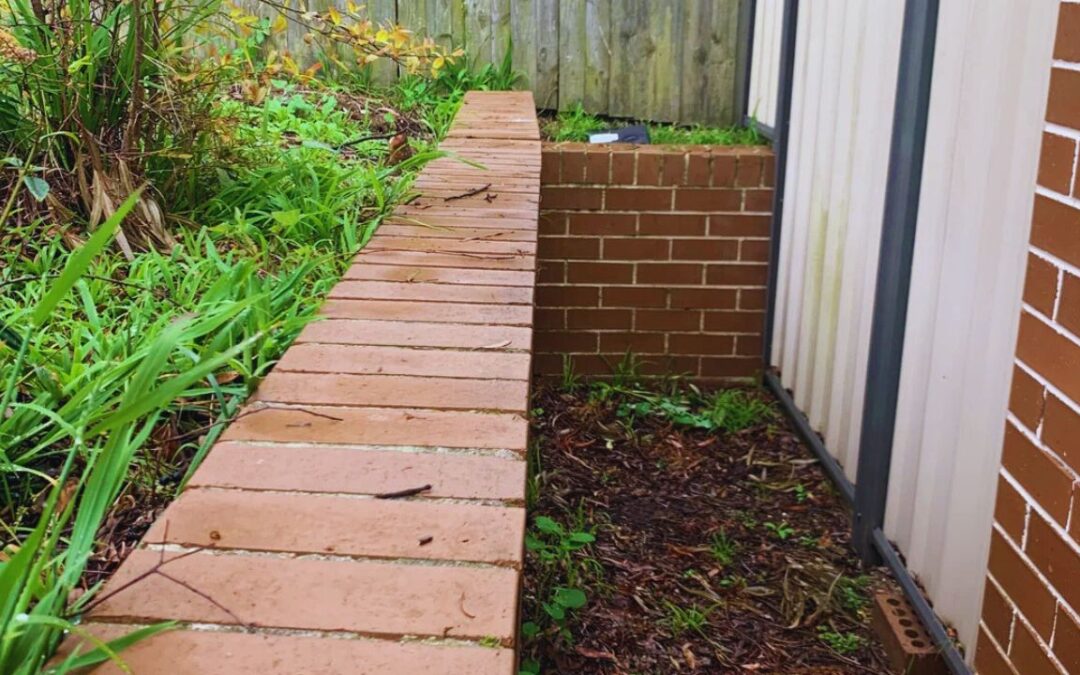A bowing retaining wall is more than a visual issue — it’s often a sign of structural stress or failure in progress. In St. Louis, where expansive clay soils, freeze thaw cycles, and heavy rain are common, walls can begin to bow under pressure if they aren’t built with the right support and drainage systems.
How to identify a bowing wall, why it happens in Missouri conditions, and what to do about it. If you’re unsure whether the issue is cosmetic or critical, keep reading to understand when it’s time to act.
What Is a Bowing Retaining Wall?
A bowing retaining wall curves inward or outward due to pressure from soil, water, or both. This is typically caused by lateral earth pressure exceeding what the wall can resist. Unlike vertical cracks, which can sometimes be harmless, bowing often indicates a wall is structurally compromised.
- Most common in clay heavy soil zones, like those found in eastern and central Missouri
- A bow greater than 1 inch per 4 feet of height generally signals structural failure (Missouri Geological Survey)
- Found in poured concrete, timber, and segmental block walls
Why Do Retaining Walls Bow in St. Louis?
Is poor drainage increasing pressure on the wall?
Yes. Hydrostatic pressure from trapped water is a leading cause of bowing. When walls lack proper drainage, water builds up behind them and exerts pressure outward.
- Lack of weep holes or blocked drainage pipes
- No gravel backfill or filter fabric
- Heavy storms saturating Missouri clay soils
According to the USDA NRCS, saturated soils can exert over 60 pounds of lateral pressure per square foot.
Can expansive clay soil cause bowing?
Yes. Missouri’s smectite rich soils expand when wet and shrink when dry, shifting the soil load on retaining walls.
- Documented across St. Louis County and eastern Missouri (MoDNR)
- Expansion rates of up to 10 percent volumetrically
- Causes gradual or sudden pressure changes throughout the year
Could poor construction or a lack of reinforcement be the issue?
Yes. Many bowing walls were built without considering soil load, wall height, or reinforcement needs.
- No geogrid or tiebacks for walls over 4 feet
- Insufficient base depth or compaction
- Dry stacked walls lacking stability in wet climates
Are tree roots or landscaping adding pressure?
Yes. Roots can push against walls and clog critical drainage features.
- Trees planted too close exert lateral force
- Shrubs and garden beds retain moisture
- Roots can crack masonry or concrete walls over time
Do freeze thaw cycles make the problem worse?
Yes. Water trapped in soil or masonry expands during freezing, then contracts. This cycle stresses wall joints and materials.
- Especially in concrete block or mortared stone walls
- Most frequent in northern Missouri or during wet winters
What Are the Signs Your Wall Needs Immediate Repair?
Homeowners should look for:
- Visible bulging or curvature
- Horizontal or stair step cracks in the middle of the wall
- Leaning at the top or base
- Shifting soil or erosion behind the wall
- Hardscape nearby (like patios or steps) moving or sinking
If multiple signs are present, your wall is likely under stress and may require professional reinforcement or replacement.
How Do You Fix a Bowing Retaining Wall?
Can drainage correction stop the bowing?
Yes. Removing excess water pressure is the first step.
- Install or clear French drains
- Add gravel backfill and filter fabric
- Maintain open weep holes every 4 to 6 feet
NRCS TR 60 recommends drainage behind all retaining walls to prevent failure.
Is structural reinforcement a viable option?
Yes, for walls with minor to moderate bowing. Options include:
- Geogrid reinforcement during rebuild or soil reinforcement
- Tiebacks or deadman anchors for lateral support
- Helical anchors for deep anchoring in problematic soils
When is a full rebuild necessary?
Walls with severe lean, separation, or deep cracks typically require rebuilding.
- Replace with engineered retaining systems
- Use reinforced concrete or segmented block with geogrid
- Build below frost line for long term performance
Are carbon fiber or steel braces useful?
Yes, but only for small walls or early stage movement.
- Often used indoors or on short exterior retaining walls
- Best when combined with drainage correction
When Should You Call a St. Louis Wall Expert?
Reach out for professional assessment if:
- Your wall bows more than 1 inch per 4 feet
- There are visible signs of shifting or deep cracking
- Drainage is failing or water is pooling
- Property is located in expansive soil zones
If you’re seeing signs of bowing, you can explore our retaining wall installation service in St. Louis for solutions tailored to local soil and drainage conditions.
Common Questions
Is bowing always a serious issue?
Yes. Bowing indicates that a retaining wall is under structural stress and may fail without reinforcement or rebuilding.
Can bowing be repaired without replacing the wall?
Yes, if caught early. Reinforcement techniques and drainage improvements can restore stability.
What’s the average cost of repair?
Expect to pay $1,500 to $6,000 for reinforcement methods like tiebacks, deadman anchors, or carbon fiber bracing. Full retaining wall rebuilds typically range from $50 to $150 per linear foot. For a 50-foot wall, this could total $7,500 to $15,000 depending on site conditions, material type, and engineering requirements.
What to Do Next
If your wall is bowing, don’t delay. The cost of early repair is always lower than emergency rebuilding. Missouri’s clay-heavy soils and seasonal rain only worsen the issue over time. Get ahead of the problem by scheduling a site inspection and exploring structural and drainage options.
Book a retaining wall evaluation with St. Louis experts today to prevent costly damage and restore long-term stability.
Sources:
- USDA NRCS Technical Release 60: https://www.nrcs.usda.gov/
- International Code Council (ICC): https://codes.iccsafe.org/
